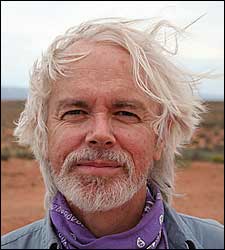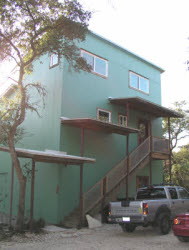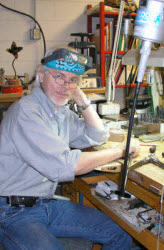James Lynn
About me:
 I live in an unconventional house (with a Big Workshop!) in the woods of the Texas Hill Country.
I live in an unconventional house (with a Big Workshop!) in the woods of the Texas Hill Country.
I began doing leatherwork back in 1968 and in 1974 I started working in precious metals. I am self-taught, and after forty years, I find there is still more to learn. Over the years, my clients have often presented me with unique challenges, giving me many opportunities to learn or invent new techniques.
 About 25 years ago, I was asked by Austin Community College to start up a jewelry education program in connection with their Art Metals, Blacksmithing, and Welding programs. The program has grown into the ACC Jewelry Department, with nine faculty members and around 200 students learning the skills to join the community of goldsmiths. I continue to teach there as a full-time professor. I'm sure I've learned as much by teaching as I ever did at the bench.
About 25 years ago, I was asked by Austin Community College to start up a jewelry education program in connection with their Art Metals, Blacksmithing, and Welding programs. The program has grown into the ACC Jewelry Department, with nine faculty members and around 200 students learning the skills to join the community of goldsmiths. I continue to teach there as a full-time professor. I'm sure I've learned as much by teaching as I ever did at the bench.
I'm really proud of my Master Bench Jeweler Certification from the Jewelers of America (www.jewelers.org). There are well over 100 CMBJ's now, of which I was the 72nd. Their certification program is based on rigorous skill testing at the workbench, and the Master Level was the toughest test I ever had to take. (To see my test pieces, click here.)
I also have long-standing interests in metal sculpture, blacksmithing, and hand raising of vessels; as well as drumming, photography, backpacking, and science, especially astronomy.
About my work:
This is hard for me to write about, as I've always believed that an artist's work should speak for itself, without need of explanation. But still, there is an expectation on the part of an audience that the artist should express some of the motivations and principles underlying the work, so here follows my attempt.
My world-view is both spiritual and scientific, aesthetic and technical. Although our culture often places these values in contention, I see them as different ways to appreciate reality--a reality that becomes more mysterious and beautiful the more one knows about it, rewarding endless fascination with endless wonder. It is this mystery and wonder that I attempt to hint at in some way in my designs. It is the challenge.
We have jewelry in our museums that was made hundreds, even thousands of years ago. Looking at these treasures, you can see the traces of a living hand and mind, perfectly transmitted through time, as personal as a touch. You can sense the maker, the giver, the wearer, the culture around them. I think about that whenever I make a piece; that it might touch hands and eyes unimaginably far away in time. I think it's really cool.
 Every artist has influences, and among mine are Art Nouveau, as exemplified by the work of Georges Fouquet, René Lalique, Alfonse Mucha, et al; Celtic design, especially the knotwork; and Art Deco. Of course, the contemporary design environment in which we live today also plays a role, and above all, I observe nature.
Every artist has influences, and among mine are Art Nouveau, as exemplified by the work of Georges Fouquet, René Lalique, Alfonse Mucha, et al; Celtic design, especially the knotwork; and Art Deco. Of course, the contemporary design environment in which we live today also plays a role, and above all, I observe nature.
All my jewelry is functional, in the sense that it is made to be worn or used and not just looked at.
I am what is called in jewelry terms a "fabricator," that is, I work directly with the metal, rather than casting it in a mold, so each piece is individually handmade. Since my interest is in the metalwork, I tend to use stones in a subordinate role, not always as a main design focus.
Incidentally, for the past few years I have chosen, when diamonds are called for, to work only with heirloom stones or those that are certified not to be conflict diamonds . (If you don’t know what those are, please take a moment to follow the link.) The diamond industry has cleaned up its act considerably in the last few years, and I now have reliable sources for conflict-free diamonds. I buy my metals from suppliers who use exclusively recycled metals in their products.
Making unusual pieces is very stimulating, but I still enjoy making mokume gane wedding rings. In our culture, wedding rings are sometimes the only really fine jewelry that non-"jewelry people" ever wear, so it's very satisfying to be able to provide something that is out of the ordinary, and that has personal meaning for them.
I have also trained in Computer-Aided Design and Manufacturing for Jewelry. It’s an exciting emerging field; fun for me, because it's like a jeweler's video game. CAD jewelry will not be displacing handmade anytime soon, if ever, but the process is useful for making items that must be geometrically precise.
Custom work calls for a special skill that I enjoy practicing, the art of communicating with clients to form an image of their desired piece of jewelry, while simultaneously expressing my own aesthetic. Experience has shown that the clients who allow me the greatest artistic freedom are those who most often get just what they want. And there’s mystery for you.

